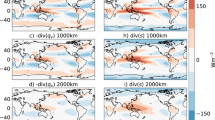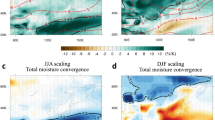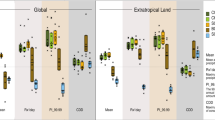Abstract
Understanding and predicting the response of the hydrological cycle to climate change is a major challenge with important societal implications. Much progress has been made in understanding the response of global average precipitation by considering the energy balances of the atmosphere and the surface1,2,3,4,5,6. This energetic perspective reveals that changes in temperature, greenhouse gases, aerosols, solar forcing and cloud feedbacks can all affect the global average rate of precipitation5,7,8,9,10,11. Local precipitation changes have conventionally been analysed using the water vapour budget, but here we show that the energetic approach can be extended to local changes in precipitation by including changes in horizontal energy transport. In simulations of twenty-first century climate change, this energy transport accounts for much of the spatial variability in precipitation change. We show that changes in radiative and surface sensible heat fluxes are a guide to the local precipitation response over land and at large scales, but not at small scales over the ocean, where cloud and water vapour radiative feedbacks dampen the response. The energetic approach described here helps bridge the gap between our understanding of global and regional precipitation changes. It could be applied to better understand the response of regional precipitation to different radiative forcings, including geo-engineering schemes, as well as to understand the differences between the fast and slow responses of regional precipitation to such forcings.
This is a preview of subscription content, access via your institution
Access options
Subscribe to this journal
Receive 12 print issues and online access
$209.00 per year
only $17.42 per issue
Buy this article
- Purchase on Springer Link
- Instant access to full article PDF
Prices may be subject to local taxes which are calculated during checkout




Similar content being viewed by others
References
Mitchell, J. F. B., Wilson, C. A. & Cunnington, W. M. On CO2 climate sensitivity and model dependence of results. Q. J. R. Meteorol. Soc. 113, 293–322 (1987).
Pierrehumbert, R. T. The hydrologic cycle in deep-time climate problems. Nature 419, 191–198 (2002).
Allen, M. R. & Ingram, W. J. Constraints on future changes in climate and the hydrologic cycle. Nature 419, 224–232 (2002).
O’Gorman, P. A. & Schneider, T. The hydrological cycle over a wide range of climates simulated with an idealized GCM. J. Clim. 21, 3815–3832 (2008).
Stephens, G. L. & Ellis, T. D. Controls of global-mean precipitation increases in global warming GCM experiments. J. Clim. 21, 6141–6155 (2008).
Schneider, T., O’Gorman, P. A. & Levine, X. J. Water vapor and the dynamics of climate changes. Rev. Geophys. 48, RG3001 (2010).
Lambert, F. H. & Webb, M. J. Dependency of global mean precipitation on surface temperature. Geophys. Res. Lett. 35, L16706 (2008).
Previdi, M. Radiative feedbacks on global precipitation. Environ. Res. Lett. 5, 025211 (2010).
Ming, Y., Ramaswamy, V. & Persad, G. Two opposing effects of absorbing aerosols on global-mean precipitation. Geophys. Res. Lett. 37, L13701 (2010).
Wild, M. & Liepert, B. The Earth radiation balance as driver of the global hydrological cycle. Environ. Res. Lett. 5, 025203 (2010).
Frieler, K., Meinshausen, M., von Deimling, T. S., Andrews, T. & Forster, P. Changes in global-mean precipitation in response to warming, greenhouse gas forcing and black carbon. Geophys. Res. Lett. 38, L04702 (2011).
Wu, P., Wood, R., Ridley, J. & Lowe, J. Temporary acceleration of the hydrological cycle in response to a CO2 rampdown. Geophys. Res. Lett. 37, L12705 (2010).
Chou, C. & Neelin, J. D. Mechanisms of global warming impacts on regional tropical precipitation. J. Clim. 17, 2688–2701 (2004).
Held, I. M. & Soden, B. J. Robust responses of the hydrological cycle to global warming. J. Clim. 19, 5686–5699 (2006).
Seager, R., Naik, N. & Vecchi, G. A. Thermodynamic and dynamic mechanisms for large-scale changes in the hydrological cycle in response to global warming. J. Clim. 23, 4651–4668 (2010).
Trenberth, K. E. Changes in precipitation with climate change. Clim. Res. 47, 123–138 (2011).
Xie, S. P. et al. Global warming pattern formation: sea surface temperature and rainfall. J. Clim. 23, 966–986 (2010).
Allan, R. P., Soden, B. J., John, V. O., Ingram, W. & Good, P. Current changes in tropical precipitation. Environ. Res. Lett. 5, 025205 (2010).
Lorenz, D. J., DeWeaver, E. T. & Vimont, D. J. Evaporation change and global warming: The role of net radiation and relative humidity. J. Geophys. Res. 115, D20118 (2010).
Liepert, B. G. & Previdi, M. Do models and observations disagree on the rainfall response to global warming? J. Clim. 22, 3156–3166 (2010).
Sohn, B. J. Cloud-induced infrared radiative heating and its implications for large-scale tropical circulations. J. Atmos. Sci. 56, 2657–2672 (1999).
Hoskins, B. J. & Karoly, D. J. The steady linear response of a spherical atmosphere to thermal and orographic forcing. J. Atmos. Sci. 38, 1179–1196 (1981).
Trenberth, K. E. & Shea, D. J. Relationships between precipitation and surface temperature. Geophys. Res. Lett. 32, L14703 (2005).
Peixoto, J. P. & Oort, A. H. Physics of Climate Ch. 13 (Amer. Inst. of Physics, 1992).
Trenberth, K. E. & Stepaniak, D. P. Covariability of components of poleward atmospheric energy transports on seasonal and interannual timescales. J. Clim. 16, 3691–3705 (2003).
Emori, S. & Brown, S. J. Dynamic and thermodynamic changes in mean and extreme precipitation under changed climate. Geophys. Res. Lett. 32, L17706 (2005).
O’Gorman, P. A. & Schneider, T. The physical basis for increases in precipitation extremes in simulations of 21st-century climate change. Proc. Natl Acad. Sci. USA 106, 14773–14777 (2009).
Muller, C. J., O’Gorman, P. A. & Back, L. E. Intensification of precipitation extremes with warming in a cloud-resolving model. J. Clim. 24, 2784–2800 (2011).
Andrews, T. & Forster, P. M. The transient response of global-mean precipitation to increasing carbon dioxide levels. Environ. Res. Lett. 5, 025212 (2010).
Betts, A. K. Thermodynamic constraint on the cloud liquid water feedback in climate models. J. Geophys. Res. 92, 8483–8485 (1987).
Acknowledgements
We acknowledge the modelling groups, the Program for Climate Model Diagnosis and Intercomparison (PCMDI) and the WCRP’s Working Group on Coupled Modelling (WGCM) for their roles in making available the WCRP CMIP3 multi-model dataset. Support of this dataset is provided by the Office of Science, US Department of Energy. C.J.M. would like to thank I. Held and G. Vecchi for useful discussions about this work.
Author information
Authors and Affiliations
Contributions
C.J.M. and P.A.O. designed the study. C.J.M. performed the analysis and wrote the paper. Both authors discussed the results and edited the manuscript.
Corresponding author
Ethics declarations
Competing interests
The authors declare no competing financial interests.
Supplementary information
Supplementary Information
Supplementary Information (PDF 5913 kb)
Rights and permissions
About this article
Cite this article
Muller, C., O’Gorman, P. An energetic perspective on the regional response of precipitation to climate change. Nature Clim Change 1, 266–271 (2011). https://doi.org/10.1038/nclimate1169
Received:
Accepted:
Published:
Issue Date:
DOI: https://doi.org/10.1038/nclimate1169
This article is cited by
-
Sea surface warming patterns drive hydrological sensitivity uncertainties
Nature Climate Change (2023)
-
Surface warming and wetting due to methane’s long-wave radiative effects muted by short-wave absorption
Nature Geoscience (2023)
-
Constrained tropical land temperature-precipitation sensitivity reveals decreasing evapotranspiration and faster vegetation greening in CMIP6 projections
npj Climate and Atmospheric Science (2023)
-
Integrated changes in tropical precipitation and circulation under global warming: moist static energy budget and the role of sea surface warming pattern
Climate Dynamics (2023)
-
Orbital-scale dynamic vegetation feedback caused the Holocene precipitation decline in northern China
Communications Earth & Environment (2022)



